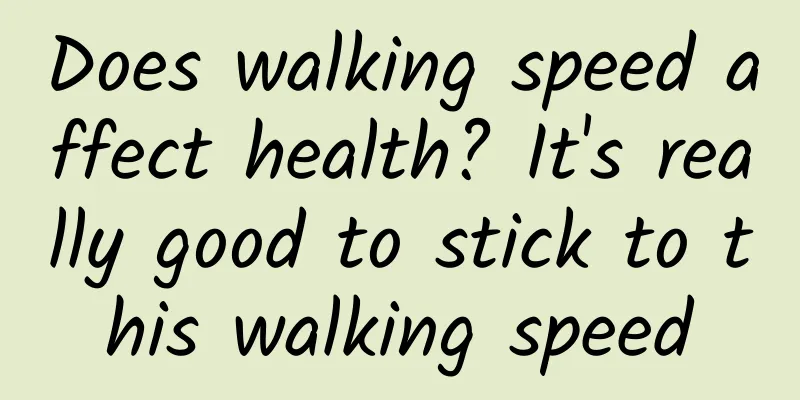Does walking speed affect health? It's really good to stick to this walking speed

|
Walking is something we do every day It is also one of the most common sports It is the simplest sport and also the most error prone sport. Many people are obsessed with the number of steps they walk every day. I think the more you walk, the better. In fact, in addition to looking at how many steps you take every day Also pay attention to how many steps you take per minute. That is, walking speed Your health status can also be seen from your walking speed! How can you walk to become healthier and live longer? What other benefits does walking fast have on your body? Let’s find out together~ 1. Does walking speed affect health? In 2019, the Mayo Clinic Journal in the United States monitored and studied the walking speed and body mass index of 475,000 people for 7 years. The subjects regularly submitted these two data to the researchers, and the researchers estimated their life expectancy by analyzing the data model. A total of 12,800 people died in 7 years. The results showed that regardless of the body mass index, people who walk fast have longer life expectancy. In this study, women who walk fast are expected to live an average of 86.7 to 87.8 years old, and men who walk fast are expected to live 85.2 to 86.8 years old. Women who walk slowly are expected to live an average of 72.4 years, while men are expected to live 64.8 years. It is calculated that people who walk fast can live about 15 to 20 years longer. 2. What other benefits does walking fast have on your body? 01. Enhance cardiopulmonary function Long-term brisk walking can enhance myocardial contractility, exercise lung function, and help prevent chronic diseases such as hypertension, hyperlipidemia, and fatty liver. 02. Reduce the risk of cancer Studies have found that insisting on brisk walking has obvious benefits for the treatment and recovery of diseases such as breast cancer, prostate cancer, and colon cancer. 03. Improve blood vessel elasticity Brisk walking can promote blood circulation and help prevent cardiovascular disease. Compared with jogging, brisk walking is more effective in controlling blood sugar in patients with prediabetes. 04. Prevent osteoporosis When walking briskly, the dual stimulation of gravity and muscle contraction can help the human body maintain bone mass, increase muscle strength and improve joint stability. 05Keep in good shape When walking fast, the arm swing amplitude and strength increase, which can mobilize the muscles of the whole body to exercise together, consume more calories, and have a significant effect on improving cardiopulmonary function, bones, muscle strength, physical strength, endurance, etc., which can give the body a more comprehensive exercise. 06Aging slower A study published in Communications Biology pointed out that when analyzed from the perspective of telomeres (telomere length is considered a key marker of biological age), maintaining a fast walking pace can make the biological age younger by up to about 16 years. After adjusting for other influencing factors, the physiological age can still be younger by up to 2 years. 3. How to walk briskly and healthily? 01 Pace : Maintain the frequency and breathe slightly when speaking Maintaining a certain frequency during walking can better improve cardiopulmonary function and achieve fitness and weight loss effects. Generally speaking, men should walk 90 to 130 steps per minute, and women should walk 80 to 120 steps per minute. You can judge by the state of talking while walking: Generally speaking, if you feel a little breathless while walking, but can talk comfortably, it means that the walking speed is moderate and has reached the standard of brisk walking. 02. Maximum heart rate : 60-80% of (220-age) Heart rate is a simple indicator of exercise intensity and duration, generally 60% to 80% of the maximum heart rate (220-age). The recommended heart rate for elderly people is 120 to 140 beats per minute. For patients with coronary heart disease and poor heart function, brisk walking can reach 70% of the expected maximum heart rate, and continued exercise can improve heart function. Moderate-intensity brisk walking can improve cardiopulmonary function and aerobic metabolism. If you are in poor physical condition or feel unwell, you need to lower this rate. 03 Frequency : 6,000 steps Healthy people should walk in one go, avoid stopping and starting, and walk 6,000 steps a day. People who want to lose weight can do more. The elderly or those in poor physical condition can reduce the amount according to their own conditions. **04. Duration: **More than 10 minutes If you have enough time, it is best to exercise for more than 30 minutes each time. If you can't spare a whole block of time to exercise, you can also complete it in several times, and it is best to walk continuously for more than 10 minutes each time. 05. Stride : Not too big Walking fast with big steps can easily strain the ligaments on the inside of the thigh, accelerate joint wear, and fail to increase walking speed. When walking briskly, each step should be 10 cm further forward than usual. At the beginning, you should proceed step by step and make adjustments based on your basic health conditions. 06. Location : Good air quality The air pollution in the streets is serious and not suitable for exercise. It is best to choose a park with green plants or a professional sports venue for brisk walking. 07. Warm up : Must do You can walk slowly for 5-10 minutes before brisk walking to give your body some time to adapt. Do not stop exercising suddenly for 5-10 minutes after the exercise, but gradually slow down to allow your heartbeat to gradually return to a calm state. 08. Posture : Keep your head up and your chest out When walking briskly, you should keep your head up and chest out. When swinging your arms, use your shoulder joints as the axis and swing them naturally back and forth. When landing, you can try to quickly roll your center of gravity to the forefoot with the arch of your foot after your heel lands. You can also use the midfoot or forefoot landing posture. The steps should be light when landing, and you should not be too heavy or too big. 4. Walking like this puts a strain on your body 01 Taking too big steps can hurt your knees If you take too big steps when walking, the cushioning force of the soles of your feet will be reduced, which will aggravate joint damage for people with bad knee joints. If you are walking briskly, your stride can be slightly larger, but it should not affect your foot's landing. 02Dragging your feet on the ground can hurt your arches Some people "drag" their feet on the ground when they walk, and land on the soles of their feet. This walking posture has poor cushioning and is prone to strain on joints, muscles, and arches. It is recommended to strengthen the ankle and calf strength in daily life. The simplest way is to tiptoe frequently. 03 The eight-character step wears out the joints People who are used to walking with their feet folded inwards and outwards will experience excessive wear and tear on their hip joints and knees because their points of force and impact are different from those of normal walkers. Mild "foot-folding" will not cause significant impact on the body, but if it is more serious, it requires timely adjustment or even medical treatment. 04 Back pain due to body tilt Many people do not stand straight when they walk, and they lean forward, backward, or left and right. This can easily cause back pain and affect walking speed. To change the habit of leaning when walking, you can do sit-ups to strengthen your abdominal muscles and help your body stand straighter. 5. Four abnormal walking postures or warning signs of illness 01Intermittent claudication may be caused by vascular or lumbar spinal canal disease When walking, the legs will feel sore, painful, numb or other discomforts, so that you have to stop and rest. After resting, the discomfort disappears, but the symptoms reappear when you continue walking. Clinically, this symptom is called intermittent claudication. Regardless of the cause of intermittent claudication, once the symptoms appear, it means that the disease is already serious and you should seek medical attention immediately. 02Scissor Step, Beware of Stroke Scissor steps are somewhat similar to bow legs. When walking, the two thighs are clamped together, the two knees are often close together, and one foot is easy to step on the instep of the other foot when walking. This may be a "signal" sent by cerebral infarction. The pathogenesis of cerebral infarction is a type of ischemic disease in which a blood vessel supplying blood to the brain tissue is completely blocked, causing brain tissue necrosis. If the brain nervous system is damaged, the muscles cannot be controlled, which naturally affects joint movement. 03 Penguin steps need to be suspected of Parkinson's Penguin gait is walking in small, broken steps, which may be a precursor to Parkinson's disease. Because Parkinson's patients have stiff muscles and poor balance and coordination, they are prone to falling when walking. For self-protection, the body will shorten its stride to maintain body balance, so that it walks like a penguin. 04Magnetic gait, may be positive pressure hydrocephalus Magnetic gait, that is, the feet cannot be lifted up, always walking close to the ground, as if the feet are tied with magnets and walking in a magnetic field, is a typical symptom of positive pressure hydrocephalus. Hydrocephalus can easily compress nerves and blood vessels, causing abnormal gait. If a person changes from a normal step to a magnetic step in a short period of time, he must seek medical attention immediately. |
<<: Two cases of monkeypox found in Beijing! How to treat and prevent it? Latest tips from CDC →
Recommend
Why do I feel cervical pain during sex?
When women feel cervical pain during intercourse,...
Gestational age and amniotic fluid index comparison table
The amniotic fluid of pregnant women plays an imp...
What's the best private area wash?
The female private parts belong to the female rep...
Simple and effective acupoint massage method for dysmenorrhea
Dysmenorrhea is a disease that many women have ex...
Can mold cause abortion?
Candidal vaginitis is also a gynecological diseas...
Why is my period always delayed?
For women, those few days of each month are also ...
How to build muscle for girls
Nowadays, not only male friends want to have deve...
How long can you live with advanced uterine cancer?
When uterine cancer reaches the late stage, the p...
What kind of container is not suitable for boiling eggs? Is an egg a fertilized egg or an ovum?
Common foods with high iodine content include fun...
What causes women's lower abdomen to swell and backache?
Whether it is an adolescent woman or a married wo...
Xiaomi: The total payment amount of Xiaomi 618 promotion across all channels in 2024 will exceed RMB 26.3 billion
In 2024, the total payment amount of Xiaomi's...
My period came four days early
Women are very concerned about their physiologica...
Will uterine fibroids grow larger during pregnancy?
If you have uterine fibroids, it is generally not...
Is homemade lipstick safe? How to sterilize homemade lipstick
I believe that friends who have experienced makin...









